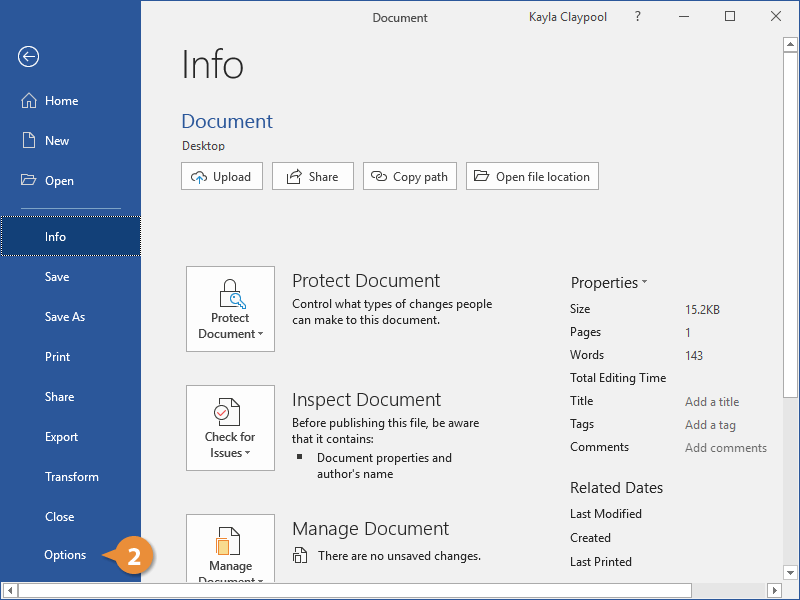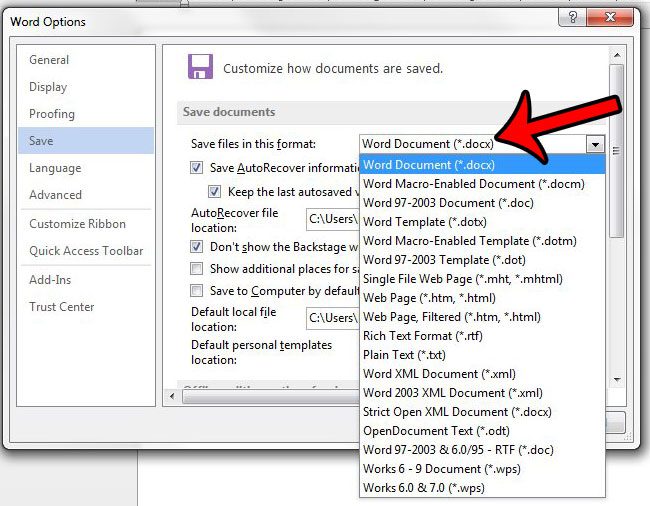

- #Microsoft word default settings for saving documents how to#
- #Microsoft word default settings for saving documents windows 10#
- #Microsoft word default settings for saving documents code#
- #Microsoft word default settings for saving documents Pc#
- #Microsoft word default settings for saving documents free#
Just like the filtered option, it saves your web page as an HTML file and saves any supporting images into their own subfolder.

The “Web Page” option on the “Save As Type” dropdown menu works just a bit differently. And, you’ll need to upload that folder of images to your website, too.Īlthough, as we’ll talk about a bit later, you can change that default behavior. By default, Word saves the actual html file in whatever folder you selected, and all the supporting images on the page to a subfolder.

You can load it up in your browser to check it out, or upload it to your web site. Now, you’ll have a web page saved to your chosen location. In the menu that appears, type a title for your web page, and then click the “OK” button.Ī warning box appears asking if you’re sure you want to convert the document to an HTML file, because it will remove Office-specific tags and features. In the Save as Type dropdown, click the “Web Page, Filtered” option. You should only choose this file type if you don’t plan to convert the web page back to a Word document later-which, let’s face it, isn’t really a thing people do often.
#Microsoft word default settings for saving documents code#
This gives you the cleanest code and fastest page loading time for your web page, but it also strips Word-specific formatting elements from the document. It preserves your document’s content and formatting, but strips out a bunch of extra HTML code that you just don’t need, and keeps the file size small. In most cases, the Filtered Web Page option is the best way to save a Word document as a web page. Save Your Document as a Filtered Web Page Let’s take a closer look at those three options. Which one you should use depends on your online publishing preferences and whether or not you plan to convert the file back to a Word document later. However, each file type produces a slightly different kind of HTML file. On the menu, you’ll find three options for saving your document as a web page: Single File Web Page Web Page and Web Page, Filtered.Īll of these options will convert your document to HTML (Hypertext Markup Language), the standard for displaying text on a web page. Next, click the “Save As Type” dropdown menu. By default, the name of your Word document will already be filled in if you’ve saved it previously. Then, type a name for your page into the “File Name” box. In the Save As window, navigate to where you’d like to store your file. On the File menu, choose the “Save As” command, and then click the “Browse” option.
#Microsoft word default settings for saving documents how to#
How to Save Your Document as a Web Pageįirst, open up the document you’d like to save as a web page. If you’re using a version older than Word 2016, you might not see all the features we describe in this article, but you’ll be able to follow along with most of it. Note: We’re using Word 2016 in our examples for this article, but the ability to save a document as a web page (or HTML) has been available in many past versions of Word. But, if you have an existing Word document that you need to turn into a web page for whatever reason, Word has you covered with some built-in tools.

#Microsoft word default settings for saving documents free#
You can use Files On-Demand to free up space or to make sure files or folders are always available on your device, even when you're offline.You may not think of Word as a tool for designing web pages, and that’s okay-it’s really not very good at it, anyway.
#Microsoft word default settings for saving documents windows 10#
The OneDrive app built in to Windows 10 synchronizes your files between OneDrive and your computer, so they're backed up, protected, and available on any device. Whether you save by default to your computer or to OneDrive, all your files are available on your PC. You can change this default save location any time.
#Microsoft word default settings for saving documents Pc#
If you clicked the “Only save files to this PC” option, you set up your PC as the default save location. (Before July 2019, the screen said, "Protect your files with OneDrive.") If you clicked Next, you set up OneDrive as your default save location. While you can always choose where to save files that you create, your computer settings include default save locations for your Desktop, Documents, and Pictures files.ĭuring Windows 10 setup, you should have seen a “Back up your files with OneDrive” screen telling you about the benefits of saving your files to OneDrive.


 0 kommentar(er)
0 kommentar(er)
